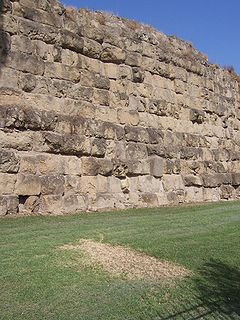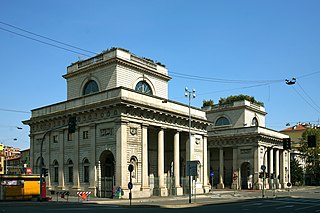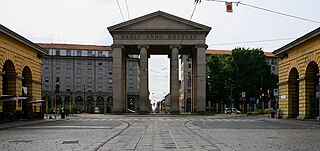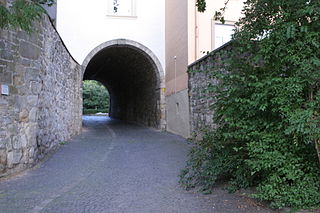
A city gate is a gate which is, or was, set within a city wall.

The Servian Wall was an ancient Roman defensive barrier constructed around the city of Rome in the early 4th century BCE. The wall was built of volcanic tuff and was up to 10 m (33 ft) in height in places, 3.6 m (12 ft) wide at its base, 11 km (6.8 mi) long, and is believed to have had 16 main gates, though none survive, and it enclosed a total area of 608 acres. In the 3rd century CE it was superseded by the construction of the larger Aurelian Walls as the city of Rome grew beyond the boundary of the Servian Wall.

The Aurelian Walls are a line of city walls built between 271 AD and 275 AD in Rome, Italy, during the reign of the Roman Emperors Aurelian and Probus. They superseded the earlier Servian Wall built during the 4th century BC.

Sforza Castle is in Milan, northern Italy. It was built in the 15th century by Francesco Sforza, Duke of Milan, on the remnants of a 14th-century fortification. Later renovated and enlarged, in the 16th and 17th centuries it was one of the largest citadels in Europe. Extensively rebuilt by Luca Beltrami in 1891–1905, it now houses several of the city's museums and art collections.

The Porta Maggiore, or Porta Prenestina, is one of the eastern gates in the ancient but well-preserved 3rd-century Aurelian Walls of Rome.

Porta Sempione is a city gate of Milan, Italy. The name is used both to refer to the gate proper and to the surrounding district (quartiere), a part of the Zone 1 division, including the major avenue of Corso Sempione. The gate is marked by a landmark triumphal arch called Arco della Pace, dating back to the 19th century, although its origins can be traced back to a gate of the Roman walls of Milan.

Porta Venezia is one of the historical gates of the city of Milan, Italy. In its present form, the gate dates back to the 19th century; nevertheless, its origins can be traced back to the Medieval and even the Roman walls of the city.

Porta Vittoria was a city gate in the Spanish walls of Milan, Italy. While the walls and the gate have been demolished, the name "Porta Vittoria" has remained to refer to the district ("quartiere") where the gate used to be. This district is part of the Zone 4 administrative division of Milan.

Porta Romana is a former city gate of Milan, Italy. In its present form, the gate dates back to the 16th century Spanish walls of Milan; its origins can be traced further back to the Roman walls of the city, which had a corresponding "Roman Gate" roughly in the same area. Porta Romana was the first and the main imperial entrance of the entire city of Milan, as it was the starting point of the road leading to Ancient Rome.
Porta Vigentina was one of the city gates in the Spanish walls of Milan, Italy; the gate has since been demolished, but the phrase "Porta Vigentina" is still used to refer to the district ("quartiere") where the gate used to be. The area is part of the Zone 5 administrative division of Milan.
Porta Lodovica was a city gate of the Spanish walls of Milan, Italy, named after Ludovico Sforza. Today, the name refers to the district (quartiere) of Milan where the gate used to be, which is part of the Zone 5 administrative division. The gate was demolished at the end of the 19th century; plans were made to rebuild it inside the Parco di Monza city park in Monza, but they were not implemented.

Porta Ticinese is a former city gate of Milan, Italy. The gate, facing south-west, was first created with the Spanish walls of the city, in the 16th century, but the original structure was later demolished and replaced in the early 19th century. The name "Porta Ticinese" is used both to refer to the gate proper and to the surrounding district, part of the Zone 6 administrative division. In the same district there is also a homonymous medieval gate, although in common speech the name "Porta Ticinese" is usually assumed to refer to the 19th century gate.

Porta Genova is a neighborhood ("quartiere") of Milan, Italy, located within the Zone 6 administrative division. The name "Porta Genova" means "Genoa gate"; the district is named after a city gate of the old Spanish Walls of Milan, namely that leading to Genoa, that used to be in what is now Piazza Cantore. The only remnants of the old gate are the small buildings that used to house the customs offices, which replaced the Spanish gate in the 19th Century.

Porta Magenta, formerly known as Porta Vercellina, was one of the city gates of Milan, Italy. The gate was established in the 9th century, with the Roman walls of the city; it was moved with the medieval and Spanish walls, and was finally demolished in the 19th century. The phrase "Porta Magenta" is now used to refer to the district ("quartiere") where the gate used to be; the district is part of the Zone 7 administrative division of Milan, west of the city centre.
Porta Volta is a former city gate of Milan, Italy, part of the Spanish walls. Nowadays, the name "Porta Volta" is most commonly used to refer to the surrounding district ("quartiere"), part of the Zone 8 administrative division of the city.

The walls of Genoa constitute in their whole the several circles of walls that protected and defended the city of Genoa, former capital of the homonimous Republic. To this day, large portions of these walls remain, and Genoa has more and longer walls than any other city in Italy.
The city Milan, Italy, has had three different systems of defending walls. The oldest, Roman walls were developed in two stages, the first in the Republican and the second in the Imperial era. The second wall system was realized in the Middle Ages, after the destruction of the city by Frederick I Barbarossa. Finally, the latest wall system was built by the Spanish rulers. While very little remains of these walls, their structure is clearly reflected in the urbanistic layout of the city. In particular, modern Milan has two roughly circular rings of streets, namely the "Cerchia dei Navigli" and the "Cerchia dei Bastioni", which essentially correspond to the Medieval and Spanish walls, respectively. Note that a third ring of roads just beyond the Inner Ring Road, called the External Ring Road, does not owe itself to any old city walls; but was part of the 1884 Beruto Plan for the city of Milan, created and named after a municipal engineer and public servant to the local city government.

The Zone 1 of Milan is one of the 9 administrative zones of Milan, Italy.

Porta Santo Spirito is one of the gates of the Leonine walls in Rome (Italy). It rises on the back side of the Hospital of the same name, in Via dei Penitenzieri, close to the crossing with Piazza della Rovere.

A pincer gate is a gate in a fortification that is deeply embedded between two inward angled exterior walls. Those wishing to enter the fort have to approach what is in effect a sunken road and, if hostile, can be attacked from both side walls in a pincer fashion.















